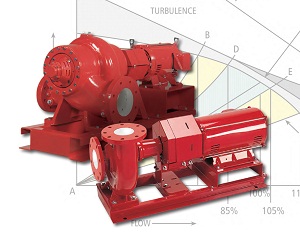| An engineer in Michigan called about a large project with several pumps being selected in parallel for a plant chilled water system. He commented that the Bell and Gossett pump curves are flat vs. processing pumps which often times are steep. His question was, “Why are B&G curves so flat?” I’ve not heard this comment for many years. What did he mean?
The term steep curve comes from the process industry. This old term refers to a large change in pump head with a small change in flow rate. Often times, process pumps have dirt or sludge which is removed by a strainer or filter. Look at figure 35 from the ITT Bell and Gossett pump selection manual TEH-1208. If the system is going to have a filter which requires cleaning when the flow rate drops, the steep curve allows more pressure drop at a given flow rate as we drop from the design point. We don’t have to change the filter as often. A large change in pressure drop produces a small change in flow.
ITT Bell and Gossett pumps are designed to be flat because they are applied, most often, in systems with control valves. As the control valve starts to close, you want a large change in flow rate. Reducing the flow lowers the BTUH output of the coil or terminal unit. The flat curve pump and control valve work together well. A small change in pressure drop produces a large change in flow. So what’s the answer to the question, “Why are B&G curves so flat?” The answer is, the ITT engineers designed them that way to give you a better system. Specifying and demanding Bell and Gossett helps the system control better. Call or email your local B&G representative for a copy of Manual TEH-1208. |
||
 |
Disclaimer: R. L. Deppmann and it’s affiliates can not be held liable for issues caused by use of the information on this page. While the information comes from many years of experience and can be a valuable tool, it may not take into account special circumstances in your system and we therefore can not take responsibility for actions that result from this information. Please feel free to contact us if you do have any questions.
Archives – Click here for Past Articles


